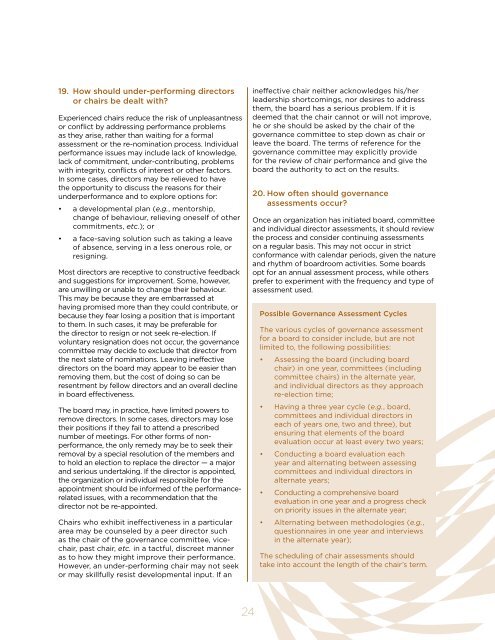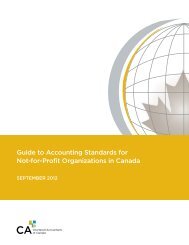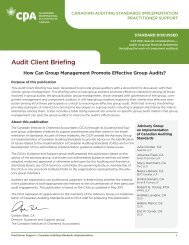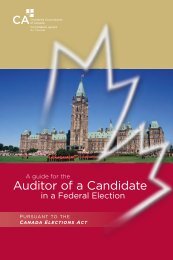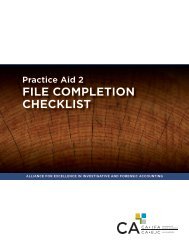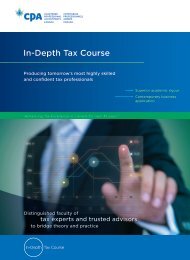20 Questions Directors of Not-for-Profit Organizations Should Ask ...
20 Questions Directors of Not-for-Profit Organizations Should Ask ...
20 Questions Directors of Not-for-Profit Organizations Should Ask ...
You also want an ePaper? Increase the reach of your titles
YUMPU automatically turns print PDFs into web optimized ePapers that Google loves.
19. How should under-per<strong>for</strong>ming directors<br />
or chairs be dealt with<br />
Experienced chairs reduce the risk <strong>of</strong> unpleasantness<br />
or conflict by addressing per<strong>for</strong>mance problems<br />
as they arise, rather than waiting <strong>for</strong> a <strong>for</strong>mal<br />
assessment or the re-nomination process. Individual<br />
per<strong>for</strong>mance issues may include lack <strong>of</strong> knowledge,<br />
lack <strong>of</strong> commitment, under-contributing, problems<br />
with integrity, conflicts <strong>of</strong> interest or other factors.<br />
In some cases, directors may be relieved to have<br />
the opportunity to discuss the reasons <strong>for</strong> their<br />
underper<strong>for</strong>mance and to explore options <strong>for</strong>:<br />
• a developmental plan ( e.g., mentorship,<br />
change <strong>of</strong> behaviour, relieving oneself <strong>of</strong> other<br />
commitments, etc.); or<br />
• a face-saving solution such as taking a leave<br />
<strong>of</strong> absence, serving in a less onerous role, or<br />
resigning.<br />
Most directors are receptive to constructive feedback<br />
and suggestions <strong>for</strong> improvement. Some, however,<br />
are unwilling or unable to change their behaviour.<br />
This may be because they are embarrassed at<br />
having promised more than they could contribute, or<br />
because they fear losing a position that is important<br />
to them. In such cases, it may be preferable <strong>for</strong><br />
the director to resign or not seek re-election. If<br />
voluntary resignation does not occur, the governance<br />
committee may decide to exclude that director from<br />
the next slate <strong>of</strong> nominations. Leaving ineffective<br />
directors on the board may appear to be easier than<br />
removing them, but the cost <strong>of</strong> doing so can be<br />
resentment by fellow directors and an overall decline<br />
in board effectiveness.<br />
The board may, in practice, have limited powers to<br />
remove directors. In some cases, directors may lose<br />
their positions if they fail to attend a prescribed<br />
number <strong>of</strong> meetings. For other <strong>for</strong>ms <strong>of</strong> nonper<strong>for</strong>mance,<br />
the only remedy may be to seek their<br />
removal by a special resolution <strong>of</strong> the members and<br />
to hold an election to replace the director — a major<br />
and serious undertaking. If the director is appointed,<br />
the organization or individual responsible <strong>for</strong> the<br />
appointment should be in<strong>for</strong>med <strong>of</strong> the per<strong>for</strong>mancerelated<br />
issues, with a recommendation that the<br />
director not be re-appointed.<br />
Chairs who exhibit ineffectiveness in a particular<br />
area may be counseled by a peer director such<br />
as the chair <strong>of</strong> the governance committee, vicechair,<br />
past chair, etc. in a tactful, discreet manner<br />
as to how they might improve their per<strong>for</strong>mance.<br />
However, an under-per<strong>for</strong>ming chair may not seek<br />
or may skillfully resist developmental input. If an<br />
ineffective chair neither acknowledges his/her<br />
leadership shortcomings, nor desires to address<br />
them, the board has a serious problem. If it is<br />
deemed that the chair cannot or will not improve,<br />
he or she should be asked by the chair <strong>of</strong> the<br />
governance committee to step down as chair or<br />
leave the board. The terms <strong>of</strong> reference <strong>for</strong> the<br />
governance committee may explicitly provide<br />
<strong>for</strong> the review <strong>of</strong> chair per<strong>for</strong>mance and give the<br />
board the authority to act on the results.<br />
<strong>20</strong>. How <strong>of</strong>ten should governance<br />
assessments occur<br />
Once an organization has initiated board, committee<br />
and individual director assessments, it should review<br />
the process and consider continuing assessments<br />
on a regular basis. This may not occur in strict<br />
con<strong>for</strong>mance with calendar periods, given the nature<br />
and rhythm <strong>of</strong> boardroom activities. Some boards<br />
opt <strong>for</strong> an annual assessment process, while others<br />
prefer to experiment with the frequency and type <strong>of</strong><br />
assessment used.<br />
Possible Governance Assessment Cycles<br />
The various cycles <strong>of</strong> governance assessment<br />
<strong>for</strong> a board to consider include, but are not<br />
limited to, the following possibilities:<br />
• Assessing the board (including board<br />
chair) in one year, committees (including<br />
committee chairs) in the alternate year,<br />
and individual directors as they approach<br />
re-election time;<br />
• Having a three year cycle ( e.g., board,<br />
committees and individual directors in<br />
each <strong>of</strong> years one, two and three), but<br />
ensuring that elements <strong>of</strong> the board<br />
evaluation occur at least every two years;<br />
• Conducting a board evaluation each<br />
year and alternating between assessing<br />
committees and individual directors in<br />
alternate years;<br />
• Conducting a comprehensive board<br />
evaluation in one year and a progress check<br />
on priority issues in the alternate year;<br />
• Alternating between methodologies ( e.g.,<br />
questionnaires in one year and interviews<br />
in the alternate year);<br />
The scheduling <strong>of</strong> chair assessments should<br />
take into account the length <strong>of</strong> the chair’s term.<br />
24


